|
Verdi's
La Traviata - November 2005
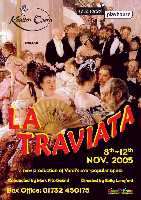 Kentish Opera made a welcome return to
Sevenoaks with their excellent production of Verdi's tragic love
story La Traviata. Kentish Opera made a welcome return to
Sevenoaks with their excellent production of Verdi's tragic love
story La Traviata.
As soon as the curtain went up, the set and costumes, designed
by Enid Strutt and Carol Stevenson respectively, were so dazzling,
particularly in the ball scenes, that you felt you really were
stepping into Parisian high society.
Special mention has to go to Colin Martin, who has been lighting
designer for the group for 50 years and without whom the excellence
of the stage setting would mean nothing.
The mise-en-scene was only matched by the chemistry between the
two leading characters. Ruth Kerr, as Violetta and David Newman,
as Alfredo, have a very natural on stage rapport.
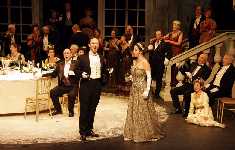 Kerr, who was stunning
throughout, both vocally and in appearance, comfortably handled
the rigours of this difficult part - which culminates in her
having to sing lying flat on her back in the throes of death. Kerr, who was stunning
throughout, both vocally and in appearance, comfortably handled
the rigours of this difficult part - which culminates in her
having to sing lying flat on her back in the throes of death.
Meanwhile, Newman has a perfect voice for the role of Alfredo
- strong, passionate and tinged with sadness. Other notable performances
came from the dastardly duo of Gary Coward, as Alfredo's father
and Freddie Tong, as the Baron.
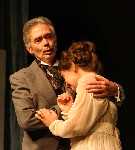 The highlight of the performance,
though, was the second ball scene, which had everything. Firstly,
the chorus was in full voice, the women were at their coquettish
best while the men sung powerfully. The highlight of the performance,
though, was the second ball scene, which had everything. Firstly,
the chorus was in full voice, the women were at their coquettish
best while the men sung powerfully.
Then the dance interlude, directed by Terry John Bates, added
an exotic feel until the music, conducted by the experienced
hand of Mark Fitz-Gerald, rose to a powerful crescendo, culminating
in the Baron challenging Alfredo to a duel.
In essence, this is what makes Kentish Opera so special. It is
the pulling together of all the elements of opera, under the
expert command of director Sally Langford, to create a powerful,
epic, professional production.
Ally McKay
Sevenoaks
Chronicle
Death
Becomes Her
Kentish Opera brought
yet another sumptuous and memorable production to the Sevenoaks
playhouse with Sally Langford's slightly contentious version
of Verdi's La Traviata, writes Roy Atterbury.
 With a cast of almost 70
singers, actors and dancers, the stage was often awash with superbly
colourful costumes (designed by Carol Stevenson) and imposing
sets (Enid Strutt) as well as a near constant demonstration of
choreography and dance by dance director Terry John Bates at
its most effective and entertaining. With a cast of almost 70
singers, actors and dancers, the stage was often awash with superbly
colourful costumes (designed by Carol Stevenson) and imposing
sets (Enid Strutt) as well as a near constant demonstration of
choreography and dance by dance director Terry John Bates at
its most effective and entertaining.
 However, the adaptation
of Dumas' novel The Lady of the Camellias provides a powerful
story line which needs both good actors and singers in the principal
roles. However, the adaptation
of Dumas' novel The Lady of the Camellias provides a powerful
story line which needs both good actors and singers in the principal
roles.
Although some parts were rotated during the six day run, the
cast on the Wednesday were outstanding, with the splendid bass-baritone
of Freddie Tong as Baron Douphol, the equally potent baritone
of Michael Fitchew as Germont and Rachel Harland's beautifully
pitched soprano as Annina (Violetta's maid) all underscoring
the quality of the performances.
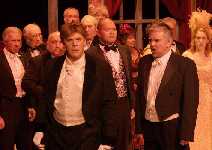 In the lead roles, soprano
Claire Surman as the tragic Violetta and tenor Philip O'Brien
as her luckless suitor Alfredo were perfect for the parts. In the lead roles, soprano
Claire Surman as the tragic Violetta and tenor Philip O'Brien
as her luckless suitor Alfredo were perfect for the parts.
On the whole, most of the production was verging on the traditional
and the way in which Violetta slowly changed from being a radiant
beauty to a gaunt shadow of her former self was a triumph for
the actress and the director.
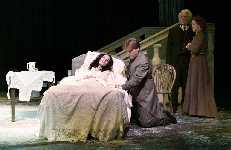 However, the death scene
at the end was given a far greater dramatic impact by Sally Langford
and, instead of just fading away and her hand falling to the
side of the bed, Violetta suddenly got to her feet and, with
renewed energy, became like her former self for a short few seconds. However, the death scene
at the end was given a far greater dramatic impact by Sally Langford
and, instead of just fading away and her hand falling to the
side of the bed, Violetta suddenly got to her feet and, with
renewed energy, became like her former self for a short few seconds.
Then she crumpled to the floor and was lifted back into the bed
where she succumbed. I believe that this sequence worked very
well and had been well conceived by the director - but I suspect
that many members of the audiences might have been shocked by
the innovation.
Whatever the patrons might have thought, few could have contested
the fact that this was opera at its very best, with great support
from the outstanding orchestra, conducted by Mark Fitz-Gerald,
which was another layer of icing on a luscious cake.
Roy Atterbury
Kentish Times
A letter addressed
to the Director of Kentish Opera
Dear Sir,
I had the pleasure
of attending the first night performance of the Kentish Opera's
La Traviata at the Sevenoaks Playhouse on 9th November. It was
also my first visit to that theatre, and the design of the auditorium
with its wonderful acoustic response ensured a perfect viewpoint
and sound for the audience of 450.
I have been to
many productions of Traviata in Italy and France, mostly when
touring the provincial areas of each, avoiding main tourist venues,
so mostly the theatres were of about the same size as The Playhouse,
and attended by local populations. Many operatic productions
I have also enjoyed at Covent Garden, but only many years ago
when it was easily possible to afford the cost of a ticket on
a student's income, and I got there once every week.
That production
of 9th November was faultless. The voices were very good indeed,
especially Violetta - enchanting young woman. It is exactly one
month since I was there, but I am still mystified by the quality
of movement control shown in the great ensembles within such
a limited space. The size of my main living room is 24ft x 18ft
which look about equivalent to the useable floor area during
the ensembles, and there was not one collision - even though
so many people were moving, including Violetta who jumped onto
a sofa.
The energy put
into the production and the sincerity displayed by all in the
performance, including that wonderful small orchestra, equalled
the best I have ever been to in Europe. I must add value to this
opinion by telling you that I hardly noticed it was being sung
in English.
The costumes were
very attractively made and a joy to look at - but that would
need another letter of appreciation written by someone better
professionally able to do so than I.
Please send me
a list of your future performances forthcoming through 2006 and
where they will be shown. Don't forget.
With admiration
and warm regards to the whole company,
Clifford Cole
|

